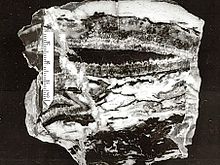Cavity structure

As cavity structure cavities are in micritic or arenitischen carbonate referred that during the deposition or during diagenesis have emerged. The cavities can be irregularly distributed or arranged in layers in the rock. In the (further) course of the diagenesis, they are usually either mechanically filled with sediment (so-called internal sediment ) and / or cemented with later calcite . Cavities that are only half-filled with internal sediment form what are known as geopetal structures , which can be used as “fossil levels”.
The formation of the cavities can be traced back to various causes. The cavities can, for example, correspond to organisms that no longer exist or have been created by burrowing and digging activities by organisms (including crustaceans ) in the sediment. Also gas bubbles from decaying organisms primarily by microbial mats supported air pockets skid in the mud or reduction in dewatering of the sediment can lead to the formation of such voids. Shrinkage pores can occur as the sediment dries out. Mineral transformations , for example from gypsum to anhydrite , and the associated volume loss can also be responsible for the formation of cavities in the rock.
Cavity structures occur as Stromatactis structures in (predominantly Paleozoic ) mound mounds and as window structures in sediments of the tidal bank area and the lagoon backreef area of carbonate platforms .
literature
- Erik Flügel : Microfacies of carbonate rocks. Analysis, Interpretation and Application. 2nd Edition. Springer, Berlin et al. 2010, ISBN 978-3-642-03795-5 .
- Erik Flügel: Microfacial methods of examination of limes. Springer, Berlin et al. 1978, ISBN 3-540-08583-1 .
- Collective of authors: Lexicon of Geosciences. Volume 2: Edu to Insti. Spectrum - Akademischer Verlag, Heidelberg et al. 2000, ISBN 3-8274-0421-5 , p. 438.
